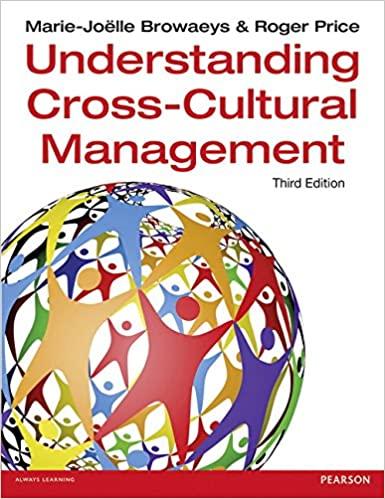Question
A company that does business in different countries in order to apply the Geert Hofstede's six cross-cultural dimensions and discussing their influence to your company.
A company that does business in different countries in order to apply the Geert Hofstede's six cross-cultural dimensions and discussing their influence to your company. You should compare the six cross-cultural dimensions of different country where you company does business and discuss how these dimensions affect the performance of your company and decision-making. For example, if you choose Vinfast, you may want to make comparison between US and Vietnam as well as Europe applying the six cross-cultural dimensions, where the company does business. You have to compare at least 2 countries, but you might want to consider to compare more than two countries in your analysis.
The theme into the specified attributes and suggest KPIs for each Socio-cultural factor:
1. Power Distance:
- KPI 1: Organizational Hierarchy Adaptation - Measure the extent to which the organization adjusts its hierarchy and decision-making structures in response to changes in power distance preferences.
- KPI 2: Employee Satisfaction with Leadership
- Conduct surveys to gauge employee satisfaction with the organization's leadership style, reflecting the alignment with cultural expectations related to power distance.
- KPI 3: Communication Openness
- Track the effectiveness of communication channels within the organization to ensure they align with cultural preferences for power distance.
- KPI 4: Leadership Accessibility
- Evaluate how accessible leaders are to employees, measuring the perceived approachability of leadership figures.
2. Individualism:
- KPI 1: Team Collaboration Effectiveness
- Assess the effectiveness of cross-functional teams and their ability to collaborate, reflecting the organization's response to individualism.
- KPI 2: Employee Autonomy
- Measure the degree of autonomy employees have in decision-making processes, indicating the level of individualism in organizational policies.
- KPI 3: Recognition Programs
- Track the success and impact of recognition programs that acknowledge individual achievements within the organization.
- KPI 4: Employee Engagement Scores
- Evaluate employee engagement scores, specifically focusing on factors related to individualism such as personal development opportunities.
3. Uncertainty Avoidance:
- KPI 1: Change Management Success Rate
- Measure the success rate of organizational change initiatives, reflecting the adaptability to uncertainty.
- KPI 2: Employee Stress Levels
- Monitor employee stress levels during periods of change or uncertainty, providing insights into the organization's effectiveness in managing uncertainty.
- KPI 3: Innovation Metrics
- Assess the organization's innovation metrics to understand its ability to thrive in ambiguous situations.
- KPI 4: Training and Development Investment
- Evaluate the investment in employee training and development programs, indicating a commitment to preparing employees for uncertainty.
4. Masculinity:
- KPI 1: Gender Pay Gap
- Analyze the gender pay gap within the organization, reflecting its adherence to or deviation from masculinity cultural dimensions.
- KPI 2: Leadership Gender Diversity
- Assess the diversity of gender in leadership positions to gauge the organization's approach to masculinity in management.
- KPI 3: Employee Work-Life Balance
- Measure employee satisfaction with work-life balance, reflecting the organization's approach to masculine values related to career success.
- KPI 4: Inclusion and Diversity Training Impact
- Evaluate the impact of inclusion and diversity training programs on creating a more inclusive culture, addressing aspects related to masculinity.
5. Long-term Orientation:
- KPI 1: Employee Retention Rates
- Track the retention rates of employees over an extended period, indicating the organization's focus on long-term relationships.
- KPI 2: Succession Planning Effectiveness
- Assess the success of succession planning initiatives, reflecting the organization's commitment to long-term goals.
- KPI 3: Investment in Skill Development
- Evaluate the organization's investment in developing employees' skills for future challenges and opportunities.
- KPI 4: Corporate Social Responsibility Impact
- Measure the impact of corporate social responsibility initiatives over the long term, reflecting the organization's commitment to societal values.
6. Indulgence:
- KPI 1: Employee Satisfaction with Workplace Culture
- Measure employee satisfaction with the overall workplace culture, with a focus on aspects related to indulgence.
- KPI 2: Employee Wellness Programs Effectiveness
- Assess the impact of wellness programs on employee well-being, reflecting the organization's response to indulgence cultural dimensions.
- KPI 3: Recognition of Personal Achievements
- Evaluate the effectiveness of programs recognizing personal achievements and milestones within the organization.
- KPI 4: Work-Life Balance Ratings
- Collect feedback on work-life balance, specifically focusing on elements related to indulgence in the workplace.
These KPIs can help assess the organization's responses to changing socio-cultural factors based on Geert Hofstede's Six Cross-cultural Dimensions. The application of these KPIs should be tailored to the specific context and nature of the organization.
apply the above question to KFC Vietnam Company.
Step by Step Solution
3.37 Rating (150 Votes )
There are 3 Steps involved in it
Step: 1
To analyze how the Geert Hofstedes six crosscultural dimensions can influence KFC Vietnam we will compare Vietnam to the United States and apply the identified KPIs for each sociocultural factor to as...
Get Instant Access to Expert-Tailored Solutions
See step-by-step solutions with expert insights and AI powered tools for academic success
Step: 2

Step: 3

Ace Your Homework with AI
Get the answers you need in no time with our AI-driven, step-by-step assistance
Get Started


